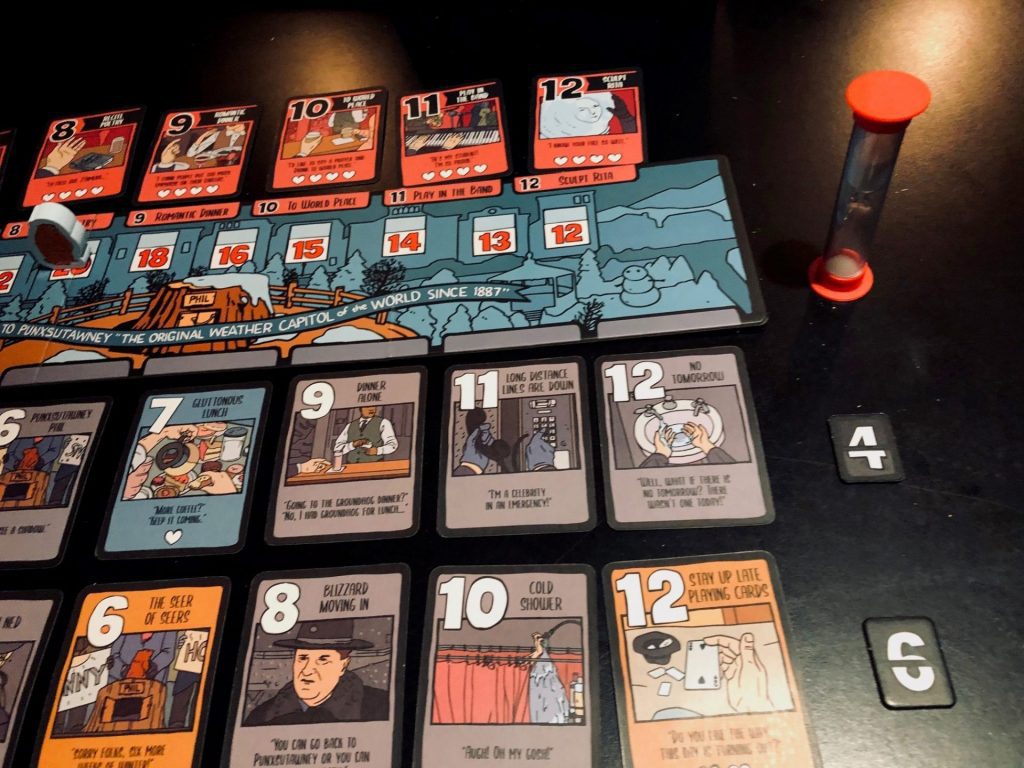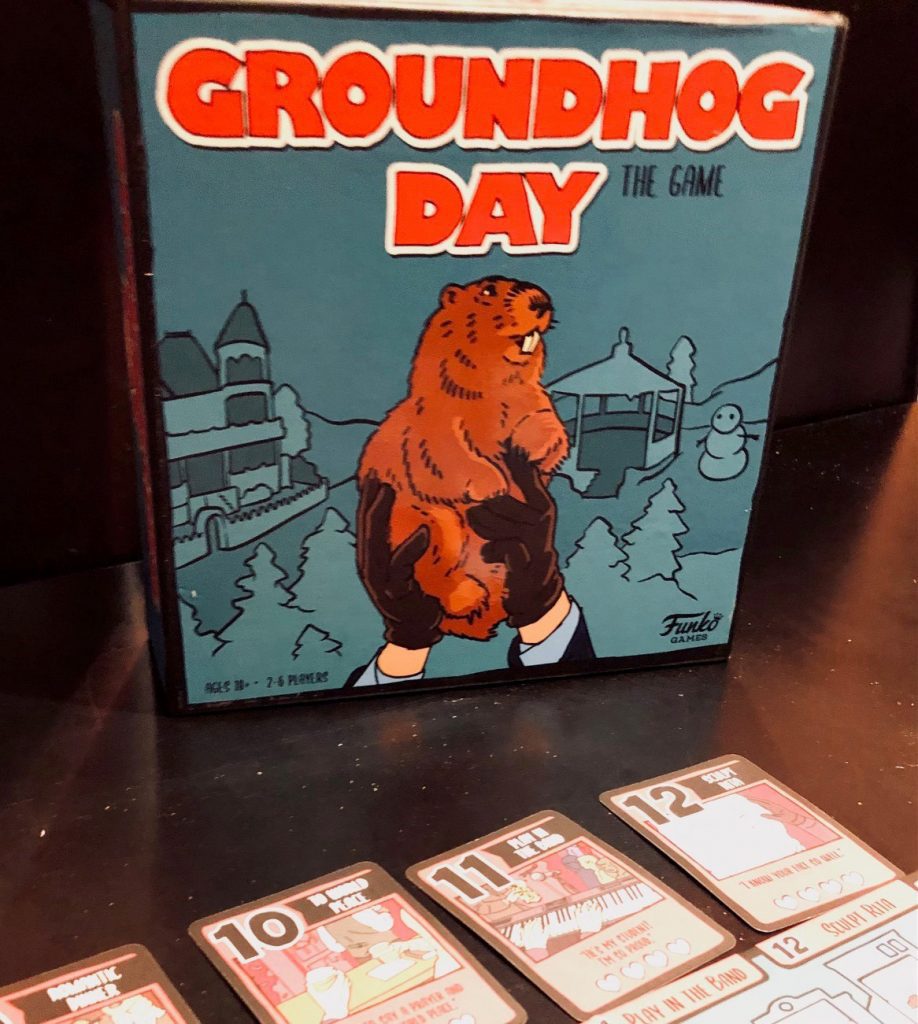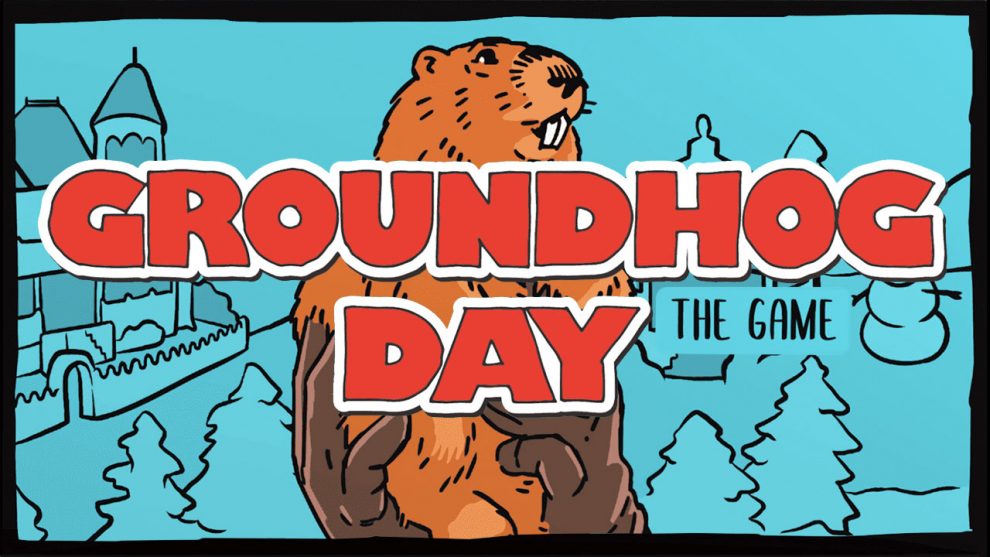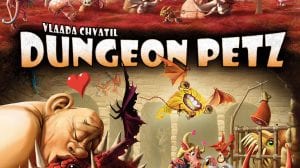Why would Funko wait nearly 28 years to release a game about a classic movie? I’d like to think it transpired something like this:
April 11, 1993: Mike Becker (no relation), the founder of a future company that won’t incorporate for five more years, sits in the theater watching Bill Murray’s movie all by his lonesome. His friends gathered that evening for rousing rounds of Pictionary, a game he stinks at because all of the stick figures Becker draws have ginormous heads. Plus, while he cherishes pop culture more than anyone he knows, he finds board games boring and uninspired.
April 11, 1996: Becker joins a table of casual acquaintances for a marathon session of Trivial Pursuit, while a VCR copy of Batman Forever plays in the background. Something in the back of his mind aspires to someday create superheroes with disproportionately sized craniums. Conversely, he rage quits and flips the table because he couldn’t remember who invaded Spain in the eighth century.
April 11, 1998: One month after incorporating Funko, he sits in on a meeting with a female Hasbro executive who appears to have intellectual property rights for everything. Becker’s efforts to cooperate are thwarted, as Hasbro hoards its IP so it can produce countless incarnations of Monopoly. Becker seethes at the greed and ignorance in the board gaming world.
April 11, 2006: Late to the party, Becker is introduced to Settlers of Catan. He’s curious, he’s intrigued, and suffers insomnia for weeks as he racks his brain about what he could use for dolls. Eventually, he builds a prototype and mails it to the Hasbro executive, along with a card “Have bobblewood for bobblesheep.”
April 11, 2019: Enough of Becker’s associates have evolved from hobbyists to enthusiasts to official board game geeks. Coming full circle, Becker weds the Hasbro executive and they have Mr. and Mrs. Monopoly Pops atop their cake. As a wedding gift, Becker hires her away from Hasbro to head Funko’s new business venture: Funko Games. She persuades him to manufacture and market hopeful classics such as Godzilla, Back to the Future, Disney, Seinfeld, and even…. Groundhog Day.
Maybe that’s not how it transpired, but a guy can dream.

Don’t Drive Angry
In Groundhog Day The Game, players cooperatively strive to recreate a perfect day for Phil — Connors, not Punxsutawney.
A perfect day consists of playing seven perfect (red) event cards from low to high, representing the span from waking up to going to bed. As the deck only begins with six perfect cards, Phil must soul search and overcome trying days before everything falls into place.
The deck consists of five suits: selfish grey, wild blue, nice orange, learning yellow, and perfect red. Each card is illustrated with an event from the film and assigned a value from 1-12, largely indicating the time of day said event occurred. Also, all of the cards have hearts to indicate Phil’s maturity. Blue cards have one heart each, nice two, learning three, and perfect four. When Phil was still selfish? He was heartless, so the grey cards are too.
To set up, position the red 7-12 cards in their designated places by the board. Select your difficulty level and start the groundhog on the appropriate number of cards to deal for the round. Shuffle and deal. It’s as easy as remembering Ned the Head Ryerson. Bing!
Until a perfect day is within reach, the goal of each round is to have a better day than the one before; this is done by accumulating more hearts. To do so, players must play seven cards from lowest to highest before the sand timer runs out. Better still, download the free Groundhog Day: The Game App and rush against a 60-second Pennsylvania polka.
“You got me?” “Yeah. I got you, babe.”
Players may freely discuss strategy – until anyone picks up their cards. Once someone looks, communication must stop. Each person can organize their hand however they deem worthwhile, and when players are ready, they press the alarm clock. Once all players are ready, start the timer.
Turns can proceed in any player order, but once a card is played, the next card must be higher. If someone plays a card equal to or lower than a card in your hand, lay your card face-up in front of you. If seven cards are played from lowest to highest before time expires, your day is over. If the timer runs out first, your game is over.

If Phil’s day is not comprised of seven red cards, you’ll progress to the next day. Every day must show improvement. Count the hearts from your current day; if that total exceeds the previous day, Phil continues to strive towards perfection. If your day’s heart total is the same – or worse – than yesterday’s, then Phil must suffer Sonny and Cher for the rest of his existence.
At the game’s start, there are six perfect, red cards (numbered 1-6) in the deck. In order to unlock the remaining perfects, someone must play the corresponding learning card during a day. Thematically, these work perfectly. The yellow 9 (drink with a twist) unlocks the red 10 (“I’d like to say a prayer and drink to world peace.”) This theme permeates the entire deck, with every 5 progressing the broadcast from sarcastic to frustrated to mediocre to energetic to heartwarming. 1s handle the alarm clock, 3s address Needlenose Ned. The artwork is stylized and a little cartoony, but I envisioned it as storyboard artwork and that helped bolster the movie idea too.

Anything different is good
Groundhog Day The Game serves as an ideal filler, combining the hectic panic of real-time with the mystic telepathy of The Game or The Mind. There’s enough strategy to feel decision-making is important, and the randomness of cards dealt means there may be games that simply cannot be won. Each new deal distributes fewer cards than the previous one, but whittling down the deck by gradually improving Phil’s days feels like an accomplishment. On top of that, tallying your heart count as you silently debate whether to play a yellow to unlock a red card or sneak the last gray card so you won’t be forced to play selfishly in late rounds? It’s a genuinely good feeling to add only one heart to yesterday’s total!
Indeed, this is one time where a simple game captures the true excitement of a large squirrel predicting the weather!
There are a few minor qualms. The card quality is subpar, and the size doesn’t match most sleeves; without sleeves, cards stuck together while I was dealing. This became especially annoying since unlike standard deals, players distribute a different number of cards each hand. When cards get sticky, you can’t simply ask if everyone has the same amount in their hand. Locate your shadow, throw the current cards back in the deck, and re-deal.
While I’ve played it with four groups now, I’ve participated in multiple strategies towards Phil’s perfect day. Like a variety of co-ops, it’s a mostly solvable, randomized puzzle; to its credit, restricting communication completely eliminates any quarterbacking issue. If all goes well, players learn as much from the game as Phil learned from his day. When that happens? I like to say a prayer and drink to world peace.












Add Comment